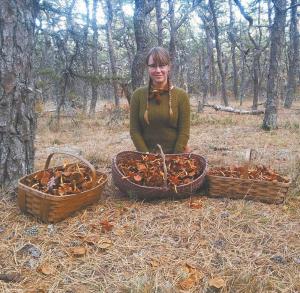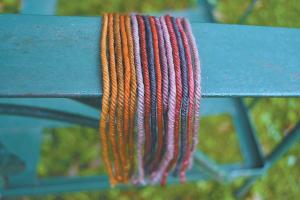2018 - Volume #42, Issue #2, Page #09
[ Sample Stories From This Issue | List of All Stories In This Issue | Print this story
| Read this issue]
Colorful Dyes Made From Mushrooms
 |
 |
“In a lot of areas, you can find any color you want by going to the woods at the right time of the year,” says Allen. “Even arid areas produce mushrooms, although the colors may not be as bright and vibrant.”
Allen travels internationally, giving workshops on finding and dyeing with local mushrooms and lichens. While a leading expert in the field, it is such a new field that she admits she is still learning.
When invited to give a workshop in South Dakota, she was surprised to discover that local mushrooms produced a beautiful range of grays and browns she hadn’t seen before. Learning what each region has to offer is part of her reason for giving the workshops.
“Throw a mushroom into a dye pot and simmer with some fabric, and it may be a total surprise what color is produced,” says Allen. “It may be nothing like the visible pigment in the mushroom.”
Allen describes the western jack-o’-lantern mushroom as being a bright orange that will stain skin orange for days. However, when simmered in a dye pot, no orange appears. Instead, fabric will be some shade of purple or green.
“Different combinations of mineral salts, such as alum or iron, and a pH modifier, such as vinegar or ammonia, will produce different colors with the same mushroom,” says Allen.
When Allen started exploring the world of mushrooms more than 20 years ago, she knew nothing about mushroom dyes or dyes in general. Only one author had ever written on the subject and then only about mushrooms local to her area of California in the 1970’s.
“Mushrooms have been used for food and medicine for thousands of year, but there is no record of them being used for dyeing fabrics,” says Allen. “Mushroom-based dyes are sort of a new field, unlike plant-based dyes that have been used forever.”
In addition to giving workshops, Allen has started several Facebook pages devoted to the craft, as well as a website. The Mushroom and Lichen Dyers United Facebook page created by Allen only a few years ago already boasts 5,000 members. Mushroom Dyers Trading Post Facebook page is a place for foragers and dyers to meet and share.
“You can’t order mushrooms for dye anywhere,” says Allen. “You have to find them yourself or have someone find them for you. The Trading Post brings people together from outside their area. A dyer from California may trade a mushroom only found in their area with a dyer in another part of the country, either for another mushroom or some other item such as jam or soap.”
One advantage mushrooms offer is they can be dried for future use. Allen uses a dehydrator to dry down mushrooms as she finds them. This also makes it easy to trade with others.
She notes that mushroom dyes only work with animal-based fabrics like wool, alpaca and angora. “Cellulose fibers like cotton and linen don’t take the dye,” says Allen. “It has to do with the microscopic nature of protein-based fibers.”
While lichen can also be used for dyes, she stresses that they should never be harvested from the living lichen. The slow growing organism may be hundreds of years old and unable to reproduce in today’s conditions. Only lichen that has fallen away from the base plant should be harvested.
To learn more about mushroom-based dyeing, attend one of Allen’s workshops listed on her website. Prices vary from $120 to $250, depending on the location and resources included. She provides the local mushrooms, wool to be dyed, and handouts, including recipes.
Allen suggests visiting one of her Facebook pages as well as her website for more information. She also recommends joining a local mycological society to learn how to identify mushrooms in your area.
Contact: FARM SHOW Followup, Alissa Allen (mycopigments@gmail.com; www.mycopigments.com; Facebook pages-Mushroom Dyers Trading Post; Mushroom and Lichen Dyers United).

Click here to download page story appeared in.

Click here to read entire issue
To read the rest of this story, download this issue below or click here to register with your account number.




